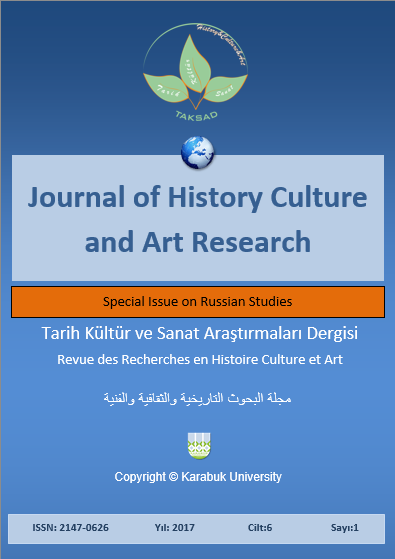Personification as the Way of Grammatical Gender Category Expression in Art Context
DOI:
https://doi.org/10.7596/taksad.v6i5.1282Keywords:
Category of Gender, Grammatical personification, Extralinguistic motivation, Anthropocentrism, Personification, Nominative significance, Gender denotation.Abstract
The study of grammatical categories in the artistic context from the position of anthropocentrism is a topical issue in modern linguistics. The greatest interest from the point of view of the relationship "language" - "man" is the category of Russian language gender, which has great stylistic resources and can be motivated extra-linguistically. In this paper, the authors analyze personification as the way of gender grammatical category expression in the artistic context of Russian writer and poet works. In the article the authors consider the linguistic picture of the world, in the creation of which the embodiment is important, the semantic-grammatical properties of which are determined by the ambivalence of animacy-inanimation category. Gender denotation occupies a special place in the interpretative structure of gender category, which presupposes a nominative significance of neutral gender nouns as a result of personification, stylization and the expression of symbolic meaning. Thus, extralinguistic possibilities of gender category are expanded, which are realized mainly in artistic speech. The authors of the article conclude that the grammatical personification of gender category as a vivid means of expression, expressiveness, imagery and emotionality is associated with a person's thinking, his worldview, psychological characteristics; and this judgment allows us to consider the category of gender not only as a morphological one, but also as a logical, mental category.
References
Alyokhina, T. A.; Shchuklina, T. Yu. & Mardieva, L. A. (2016). Teaching Russian composites: normative and derivative aspects (on the material of compound adjectives in the Russian language). Modern Journal of Language Teaching Methods, Special Issue, 207-211.
Andramonova, N. A. & Usmanova, L. A. (2014). Ethnocultural Image Constants and their Discourse Literary Correlates. Journal of Language and Literature, 5(4), 65-68.
Bogatyreva, О. L. (2008). Creative potential of the gender' category in the modern Russian language. Dissertation for the degree of candidate of philology. Moscow state university. URL: http://cheloveknauka.com/kreativnyy-potentsial-kategorii-roda-v-sovremennom-russkom-yazyke (accessed on: 04.05.2017).
Chukovsky, K. (2017) Moydodyr. URL: http://stihi-rus.ru/1/chukovskiy/14.htm (accessed on: 14.05.2017).
Corbett, G. G. & Fraser, N. M. (2000). Gender Assignment: A Typology and a Model. In G. Senft (ed.), Systems of Nominal Classification, (pp. 293-325). Cambridge.
Erofeeva, I. V. & Sadrieva, K. E. (2016). Representation of human's image by using word-formation resources in the language of Russian chronicles (using the example of nouns with suffixes –(ьн)икъ). Journal of Language and Literature, ISSN: 2078-0303, 7(1), 203-206.
Khabibullina, A. Z.; Nagumanova, E. F. & Amurskaya, O. Y. (2016). Russian Classical Literature in Multi-ethnic Environment: The Issues of Reception and Methodology of Teaching. The European Proceedings of Social & Behavioural Sciences EpSBS, 12, 75-82.
Krivin, F. D. (2017). Рolycaste. URL: http://www.vitamarg.com/pritchi?catid=0&id=88 (accessed on: 04.05.2017).
Laskova, M. V. (2001). Grammatical category of gender in the aspect of gender linguistics: Monograph. Rostov: Rostov State University.
Murzina, N. Y.; Safonova, S. S. & Chupryakova, O. A. (2016). The native/foreign binary opposition as a way of conceptualization of V. Rasputin’s artistic image of the world. Journal of Language and Literature, 7(3), 80-84.
Murzina, N. Y. & Hayrutdinova, G. A. (2015). On the issue of studying the aesthetical resources of the language (based on the material of the gender category of the Russian Substantives). Journal of Language and Literature, 6(2), 79-82.
Peshkovskii, А. М. (1996). Russian syntax in a scientific light. Мoscow: Prosveshchenie.
Petrushevskaja, L. C. (2017). Аlarm. URL: http://www.libros.am/book/read/id/42487/slug/budilnik (accessed on: 04.05.2017).
Poems about winter (2011). Pravmir. URL: http://www.pravmir.ru/stixi-pro-zimu/ (accessed: 04.05.2017).
Potebnya, A. A. (1968). From the notes on Russian grammar: In 4 vol. V.3: On the changing of meaning and the substitutions of a noun, (pp. 451-459). Moscow: Prosveshchenie.
Rakhimova, D. I. & Yusupova, Z. F. (2016). Language training of labor migrants: Methodical recommendations for teachers. Journal of Language and Literature, 7(3), 314-317.
Rasputin, V. (1980). Farewell to Matera. URL: http://lib.ru/PROZA/RASPUTIN/matera.txt (accessed on: 04.05.2017).
Safin, I. K.; Kolosova, E. I. & Bychkova, T. A. (2015). Representation of gender concepts in the Russian and Polish languages. Social Sciences, 10(5), 562-565.
Safin, I. K.; Kolosova, E. I. & Bychkova, T. A. (2016). Specifics of Teaching Grammar in the bilingual education conditions. Modern Journal of Language Teaching Methods (MJLTM), Special Issue, 111-115.
Safonova, S. S. & Zamaliutdinova, E. R. (2016). Semantics and functioning of syntactic constructions in the mass media language (Semantics and functioning of syntactic phrase models in the language of mass media). Journal of Language and Literature, 7(4), 160-164. DOI: 10.781 3/jll.201 6/7-4/27
Sepir, E. (1993). Selected works on linguistic and cultural studies. Moscow: Progress.
Yusupova, Z. F. (2016). Dialogue of Cultures of Teaching of Russian as a foreign Language in the Chinese Audience: Approaches and Solutions. IFTE 2016, 2nd International Forum On Teacher Education, 203-207.
Downloads
Published
How to Cite
Issue
Section
License
All papers licensed under Creative Commons 4.0 CC-BY.- Share — copy and redistribute the material in any medium or format
- Adapt — remix, transform, and build upon the material for any purpose, even commercially.
Under the following terms:
Attribution — You must give appropriate credit, provide a link to the license, and indicate if changes were made. You may do so in any reasonable manner, but not in any way that suggests the licensor endorses you or your use.
- No additional restrictions — You may not apply legal terms or technological measures that legally restrict others from doing anything the license permits.







